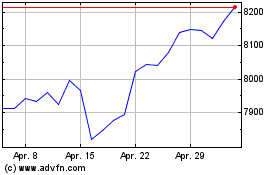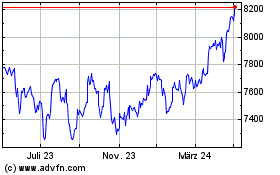By Laurence Norman in Brussels and Jenny Gross in London
A breakthrough Friday in grueling divorce talks between the U.K.
and the European Union opened the door to the next stage: tough
trade negotiations that will determine Britain's economic relations
with Europe, the U.S. and the rest of the world.
After six months of tense negotiations, the EU and the U.K.
overcame acrimony to make progress on a handful of contentious
issues around Britain's planned departure from the bloc in March
2019, including a financial settlement and the rights of British
and EU citizens to live and work in one another's territories after
Brexit.
With Friday's deal, British Prime Minister Theresa May gained
the EU's provisional assent to advance negotiations on
post-departure arrangements. She has vowed to push for an ambitious
pact that secures favorable terms of trade with Britain's biggest
trading partner, but EU officials have warned any trade deal could
be much more limited and take years to hammer out.
The agreement significantly lowered the possibility that
Britain, having decided in a close referendum vote on June 23,
2016, to leave the EU, would do so without arranging future
relations with the bloc.
While it relieved immediate pressure on Mrs. May to deliver
results, Friday's deal was reached in large part because Britain
acceded to many of the EU's requirements. The U.K. agreed to pay
the EU a net bill that British officials said would come to at
least EUR40 billion ($47 billion) in the coming years -- much more
than London's initial offer -- and to go further than it originally
intended to protect the rights of EU citizens living in the
U.K.
The most contentious issue -- how to avoid a hard border between
EU member Ireland and Northern Ireland, which is part of the U.K.
-- was left largely unresolved. Border arrangements on the island
have emerged as a major hurdle in the divorce deal, and while
Britain accepted Ireland's demand for explicit promises to resolve
the problem, the issue appears likely to cause more trouble
ahead.
Investor reaction was muted. The British pound initially traded
0.2% higher against the dollar before falling to trade 0.7% lower
at $1.3384, while the U.K.'s blue chip FTSE 100 index was up
1%.
European Commission President Jean-Claude Juncker, following a
brief meeting with Mrs. May early Friday to complete the agreement,
said his negotiating team was now formally recommending that the
leaders of EU member states agree to advance the talks when they
meet next Friday.
"I believe we have now made the breakthrough we needed," Mr.
Juncker said.
Mrs. May, who has been under pressure from competing factions
within her party since losing her parliamentary majority in June,
said both sides had made concessions. "I am optimistic about the
discussions ahead," she said.
British Foreign Secretary Boris Johnson, who has sparred with
Mrs. May over on her Brexit approach, cheered the prime minister,
saying the country would remain close to the EU while "taking back
control of our laws, money and borders for the whole of the
U.K."
Members of a WhatsApp group of euroskeptic Conservative
lawmakers on Friday said they were mostly satisfied with the
agreement, according to a lawmaker in the group. "It looks OK, as
long as her red lines on the customs union and the single market
remain," he said, referring to Mrs. May's stated position that
Britain won't surrender trade autonomy or allow unchecked EU
migration as a price for retaining fluid trade relations with the
EU.
He said pro-Brexit lawmakers could reassess their views when
difficult decisions arise on trade talks next year.
Friday's deal came together after four days of intensive
negotiations. They were sparked on Monday when Arlene Foster, the
leader of the Democratic Unionists, a Northern Irish party that
Mrs. May's Conservatives relies on for a parliamentary majority,
publicly rejected a draft agreement Mrs. May was finalizing in
Brussels.
As Downing Street staffers celebrated their annual Christmas
party late Thursday, Mrs. May and her top team were sweating over
final details. After speaking to Ireland's leader, Leo Varadkar,
and holding two late-night calls with Mrs. Foster, Mrs. May got a
few hours of sleep before heading to Brussels for predawn
meetings.
The agreement includes a British guarantee that the U.K. will do
what is necessary to avoid customs checks on the border between
Northern Ireland and the south, but is ambiguous on specifics. It
says that unless other arrangements are reached to avoid a hard
border, the U.K. will allow Northern Ireland to "maintain full
alignment" with EU rules, so that smooth economic cooperation
between Northern Ireland and Ireland can continue.
The U.K.'s plan to quit the EU single market and customs union
would effectively create two economies on the island of Ireland.
That division is hard to square with London's declared intention
not to erect a physical border between the U.K. and the Republic of
Ireland.
"We have got a cast-iron guarantee from the British government
that under no circumstances will we see a hard border. That was at
the core of what we wanted," Irish Foreign Minister Simon Coveney
told state-owned broadcaster RTE.
Anand Menon, professor of European politics at King's College
London, said the breakthrough marks significant progress, raising
the prospects that the two sides would reach a final deal and
making it much less likely that talks would collapse. But many of
the big questions, particularly around Ireland, will test both
sides, he said. "We have no clue how to sort out the Irish
question," Mr. Menon said. "The EU knows as well as we do that this
is a holding pattern."
The dispute over Northern Ireland and trade foreshadows a more
complicated question at the heart of negotiations: To what extent
will the U.K. agree to be a rule-taker versus a rule-maker?
If Britain agrees to abide by EU trade rules, it will minimize
trade barriers with the bloc. But that would bear the cost of
leaving it less scope to pursue independent trade deals with other
countries, such as the U.S.
If Britain seeks a more distant relationship with the EU, in
which it can set its own trade rules, it will have more scope to
control its own borders and laws but create trade barriers with EU
countries, which together constitute its most important trading
partner.
Mrs. May's top officials say her divided government has yet to
debate the issue.
EU chief negotiator Michel Barnier warned that if Britain's red
lines remain the same -- leaving the EU's single market and customs
union and being fully independent of EU court rulings -- a future
trade deal would likely resemble the EU's merchandise-focused trade
deal with Canada.
British officials have said they want a more ambitious deal that
includes the finance sector and other services.
Mrs. May has said Britain would request a two-year transition
period after Britain's planned exit date of March 2019 to avoid a
hard landing for the British economy. A new trade agreement can
only be signed after Britain leaves the bloc.
Friday's pact will next go to leaders of the other 27 EU
countries for approval. European Council President Donald Tusk, who
coordinates EU leaders, said he had circulated the EU's draft
guidelines -- the key principles of its approach -- to the future
trade relationship. EU leaders will need to agree and sign off that
text next Friday.
Mr. Tusk also said the EU and the U.K. should move quickly to
start negotiating the transition period to provide certainty for
businesses well in advance of Britain's departure. Talks on that
could begin in early January, officials said.
--Emre Peker in Brussels and Paul Hannon in London contributed
to this article.
Write to Laurence Norman at laurence.norman@wsj.com and Jenny
Gross at jenny.gross@wsj.com
(END) Dow Jones Newswires
December 08, 2017 18:28 ET (23:28 GMT)
Copyright (c) 2017 Dow Jones & Company, Inc.
FTSE 100
Index Chart
Von Mär 2024 bis Apr 2024

FTSE 100
Index Chart
Von Apr 2023 bis Apr 2024
